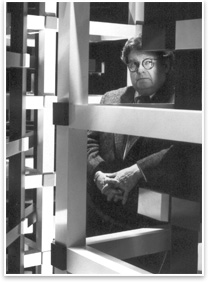
|
Stanley Tigerman Awarded 2008 AIA/ACSA Topaz Medallion
Summary: The AIA and the Association of Collegiate Schools of Architecture (ACSA) jointly announced that Stanley Tigerman, FAIA, has been named the 2008 recipient of the AIA/ACSA Topaz Medallion for Excellence in Architectural Education. The AIA/ACSA Topaz Medallion honors an individual who has made outstanding contributions to architecture education for at least 10 years, whose teaching has influenced a broad range of students, and who has helped shape the minds of those who will shape our environment. The award will be presented at the ACSA annual meeting in March 2008 in Houston and in May at the 2008 AIA National Convention in Boston. In nominating Tigerman for the Topaz Medallion, Jane Weinzapfel, FAIA, president of the Boston Society of Architects, stated: “In a culture that struggles to grasp a deep or broad understanding of the power and delight of architecture, Tigerman has been a remarkably influential and efficient advocate of the profession we love and the work we do.” Eytan Fichman, AIA, wrote in his nomination that Tigerman’s teaching is “as big as life.” Daniel Friedman, FAIA, dean of the College of Architecture and Urban Planning, University of Washington, had high praise in his nomination of Tigerman, writing that “Stanley Tigerman is the most courageous architect I’ve ever met.” Personal and professional achievements In 1963, Tigerman began his career in architecture education as a visiting critic at Cornell University’s architecture school. In 1964, he served as a visiting critic at Washington University and secured an appointment to the permanent faculty at the University of Illinois, Chicago (UIC), where he taught from 1964–1971. From 1971–1980, Tigerman was a visiting lecturer and critic at a number of architecture schools, and in 1980 returned to UIC as the director of the “Option One” program, a one-year post-professional program. In 1985, Tigerman was appointed director of UIC’s architecture school, which he directed and taught full-time until 1993. In 1994, together with Eva Maddox, he co-founded ARCHEWORKS, a one-year post-professional design school grounded in social causes, which continues today with Tigerman as its director. Tigerman’s work over a half-century has continuously blended practice and education. His numerous buildings and installations traverse the globe and grace the U.S., Bangladesh, Canada, Great Britain, Italy, Japan, Portugal, Spain, West Germany, Yugoslavia, and Puerto Rico. From his 400 projects, 185 built works embrace virtually every building type, including Chicago’s proposal for the 2016 Olympics. He has been a visiting chaired professor at numerous universities, including Yale and Harvard, and served on advisory committees of the Yale and Princeton schools of architecture, the Chicago Art Institute Department of Architecture, and Chicago Latin School’s “High Jump” program. He is the author of five books, editor of four books, and has written numerous papers and articles. His work has been exhibited in museums and galleries worldwide. Tigerman’s myriad accolades include Yale University’s first alumni Arts Award; the Dean of Architecture Award; the Illinois Academy of Fine Arts Award; the American Jewish Committee’s Cultural Achievement Award; the Louis Sullivan Award by the International Union of Bricklayers and Allied Craftworkers; an honorary bachelor of fine arts from the Harrington Institute of Design; and more than 140 design awards from the national AIA, AIA Chicago, Progressive Architecture Design Awards, and Record Houses and Interiors. In 2002, he was named Chicagoan of the Year by Chicago Magazine. He is the founding member of the Chicago Seven and The Chicago Architectural Club and, in 1990, was inducted into the Interior Design Hall of Fame.
|
||
Copyright 2007 The American Institute of Architects. All rights reserved. Home Page |
||
news headlines
practice
business
design

 by Russell Boniface
by Russell Boniface